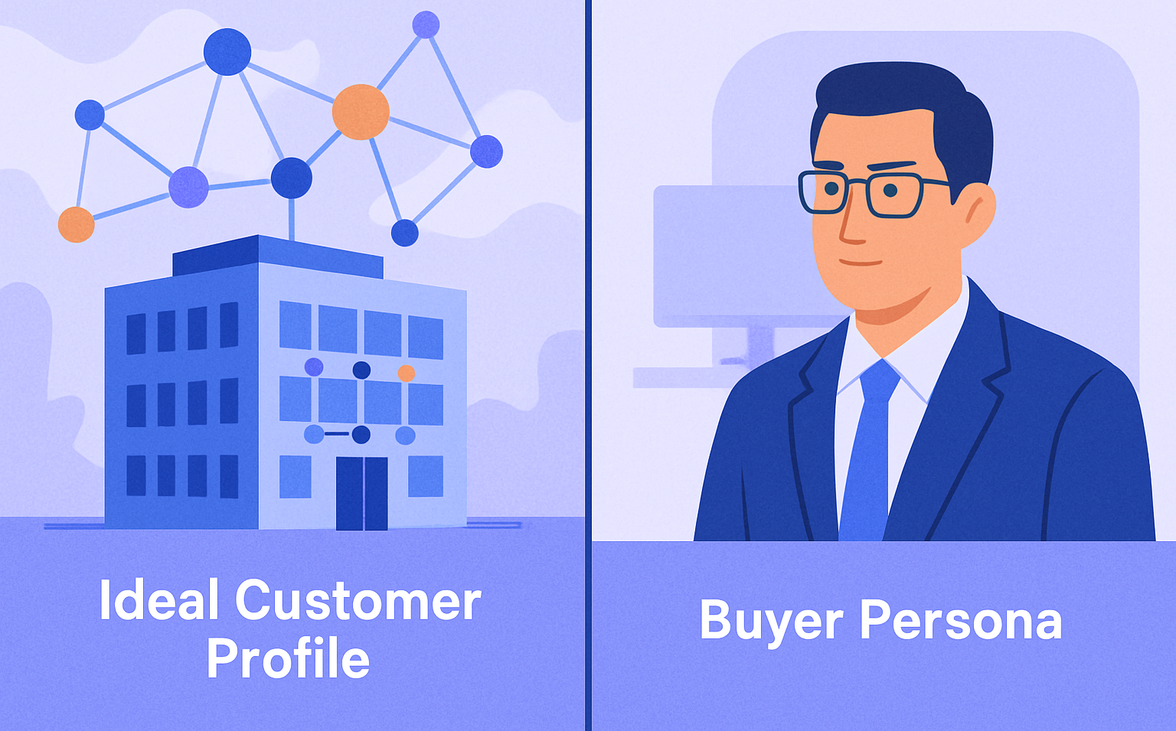Building a successful marketing or sales strategy starts with knowing who your ideal customer is - but that’s not just one person. It’s both the type of company you're targeting and the specific people within that company who make purchasing decisions.
That’s where two crucial concepts come in: the Ideal Customer Profile (ICP) and the Buyer Persona. Although they often get mixed up, each plays a distinct and essential role in customer acquisition. In this article, we’ll break down the key differences, explain how they work together, and show you how to use both effectively in your go-to-market strategy.
What Is an Ideal Customer Profile (ICP)?
An Ideal Customer Profile is a detailed description of the type of company that would benefit most from your product or service - and provide the most value to your business in return.
This is especially useful for B2B companies where the buyer is not an individual but an organization. The ICP acts as a strategic filter to help your team focus on accounts that are more likely to convert, stick around, and grow with you.
Common ICP attributes include:
-
Industry or vertical (e.g., SaaS, healthcare, fintech)
-
Company size (employees, revenue)
-
Location and target market
-
Business model (B2B, B2C, marketplace)
-
Technology stack
-
Maturity stage
-
Common pain points your solution solves
🔎 Think of the ICP as answering the question: "Which companies should we target?"
What Is a Buyer Persona?
A Buyer Persona is a semi-fictional representation of an individual decision-maker or influencer within your ideal customer organization. While the ICP defines the company, the Buyer Persona zooms in on the person.
Personas help your marketing, sales, and product teams understand how to communicate effectively with different stakeholders in the buying process.
Typical buyer persona traits include:
-
Job title and role in the company
-
Goals and KPIs
-
Daily challenges and frustrations
-
Buying triggers and objections
-
Preferred content formats and channels
-
Level of influence in the decision-making process
🔍 Think of the persona as answering the question: "Who are the key people inside those companies — and what matters to them?"
Focus |
Company |
Individual |
| Use case | Targeting accounts | Tailoring messaging |
| Data type | Firmographic (e.g. industry, size) | Demographic & psychographic |
| Goal | Find high-fit accounts | Understand and influence decision-makers |
| B2B/B2C relevance | Mostly B2B | Relevant to both B2B and B2C |
When and How to Use Each
-
ICP is best used early in the funnel - for account selection, outbound prospecting, and defining your total addressable market (TAM).
-
Buyer Personas are critical once you’re inside the account - for crafting personalized messaging, nurturing, objection handling, and enabling your sales team.
In Account-Based Marketing (ABM), for example, the ICP defines which accounts you pursue, while buyer personas shape how you engage the decision-makers within those accounts.
How They Work Together
The most effective strategies use both ICP and Buyer Personas in tandem:
-
Define your ICP to focus your resources on the right types of companies.
-
Create multiple personas within each ICP to reflect different stakeholders (e.g., CTO, marketing lead, procurement).
-
Align marketing campaigns and sales motions to speak to each persona’s specific needs — while staying within the bounds of your ICP.
Together, these tools ensure your messaging is both relevant and scalable.
Example
Let’s say you sell a security automation platform.
-
ICP: Mid-market fintech companies in the US with 200–500 employees, using AWS and facing regulatory pressure (e.g., SOC 2, ISO 27001).
-
Personas:
-
CTO: Wants to reduce risk and automate audits
-
Security Analyst: Feels overwhelmed by manual tasks
-
Head of Compliance: Needs faster evidence collection and reporting
-
Each persona has different goals and pain points - but they all live within your ideal customer profile.
Final Thoughts
Understanding the difference between an ICP and a Buyer Persona is more than a semantic exercise - it’s a foundational part of building predictable, scalable go-to-market systems. When used correctly, these frameworks help you focus, personalize, and win more of the right customers.
So the next time you're planning a campaign or launching a new product, ask yourself:
"Are we targeting the right companies - and speaking to the right people?"

